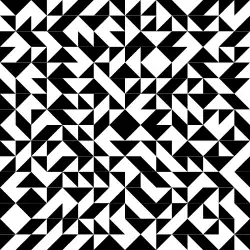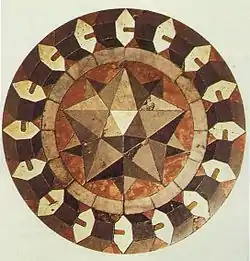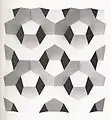Truchet tiles
In information visualization and graphic design, Truchet tiles are square tiles decorated with patterns that are not rotationally symmetric. When placed in a square tiling of the plane, they can form varied patterns, and the orientation of each tile can be used to visualize information associated with the tile's position within the tiling.[1]
Truchet tiles were first described in a 1704 memoir by Sébastien Truchet entitled "Mémoire sur les combinaisons", and were popularized in 1987 by Cyril Stanley Smith.[1][2]
Variations
Contrasting triangles
The tile originally studied by Truchet is split along the diagonal into two triangles of contrasting colors. The tile has four possible orientations.[3]

Some examples of surface filling made tiling such a pattern.
With a scheme:

With random placement:

Quarter-circles
A second common form of the Truchet tiles, due to Smith (1987), decorates each tile with two quarter-circles connecting the midpoints of adjacent sides. Each such tile has two possible orientations.


We have such a tiling:

This type of tile has also been used in abstract strategy games Trax and the Black Path Game, prior to Smith's work.[1]
Diagonal
A labyrinth can be generated by tiles in the form of a white square with a black diagonal. As with the quarter-circle tiles, each such tile has two orientations.[4]
The connectivity of the resulting labyrinth can be analyzed mathematically using percolation theory as bond percolation at the critical point of a diagonally-oriented grid.
Nick Montfort considers the single line of Commodore 64 BASIC required to generate such patterns - 10 PRINT CHR$(205.5+RND(1)); : GOTO 10 - to be "a concrete poem, a found poem".[4]

See also
| Wikimedia Commons has media related to Truchet tiles. |
References
- Browne, Cameron (2008), "Truchet curves and surfaces", Computers & Graphics, 32 (2): 268–281, doi:10.1016/j.cag.2007.10.001.
- Smith, Cyril Stanley (1987), "The tiling patterns of Sebastian Truchet and the topology of structural hierarchy", Leonardo, 20 (4): 373–385, doi:10.2307/1578535. With a translation of Truchet's text by Pauline Boucher.
- A New Kind of Science
- Montfort, Nick (2012). 10 PRINT CHR$(205.5+RND(1)); : GOTO 10. MIT Press.
External links
- Weisstein, Eric W. "Truchet Tiling". MathWorld.
- Truchet in 2D and 3D: https://web.archive.org/web/20120820024223/http://local.wasp.uwa.edu.au/~pbourke/texture_colour/periodic/
- Javascript animation: http://perso.orange.fr/jean-paul.davalan/divers/truchet/truc.html (unknown page, 19.05.06)


